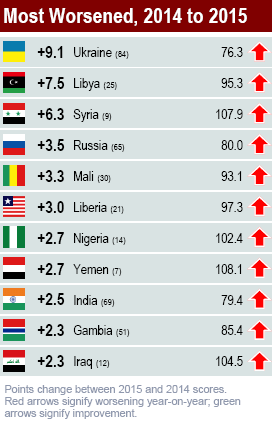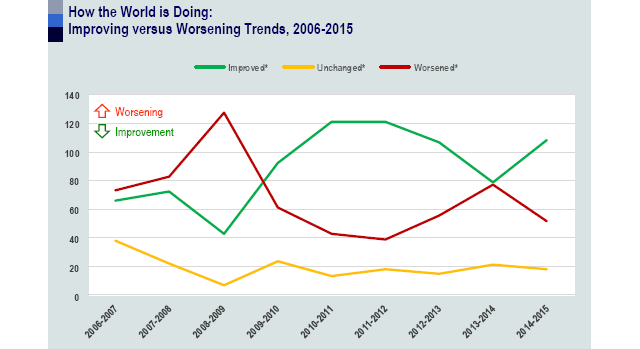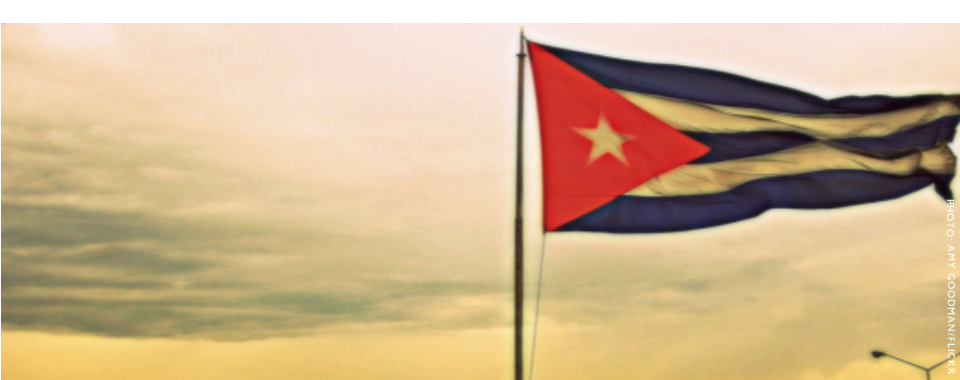BY J.J. MESSNER AND HANNAH BLYTH
South Sudan has topped the Fragile States Index for the second year in succession, as the country continues to be wracked by internal conflict, fractious politics, and poverty. South Sudan is joined at the most fragile end of the Index by countries that have long struggled, such as Somalia, Central African Republic, Sudan, and D.R. Congo. However, a lack of change at the most fragile end of the Index (not to mention a similar lack of change at the sustainable end of the Index) belies the significant movement of a number of countries over the past year and indeed the past decade.
Where the World is Getting Better

Much of the movement in the 2015 Index has been largely in sync with the headlines of the past year. As Cuba continues to dominate headlines in the United States — for all the right reasons — it has managed to be one of the three most improved countries of 2015, and also the most improved country of the past decade. Cuba is joined by Portugal and Georgia as the most improved countries, all having improved their scores by 3.4 points in the space of a year. Notably, Cuba was among the most improved countries in 2014, and Georgia was the most improved country previously in 2011, suggesting both countries are enjoying a rapid long-term trend of improvement.
Even more informative than the year-on-year trends are the trends identifiable over a decade. Not only was Cuba tied for the most improved country year-on-year in 2015, it is also the most improved country over the past decade. Though the country continues to experience problems in the provision of public services and issues such as Human Rights and State Legitimacy, it has nevertheless made great strides economically, driven by the reform agenda of Raul Castro. It is reasonable to assume that, with the thawing of the relationship between the United States and Cuba, this trend will continue to be positive over the coming years.
Improving by 3.4 points in this year’s Index, 2014 saw Georgia make strides in economic growth, trade, and government transparency. Signing an association agreement with the European Union in June along with Moldova and Ukraine, Georgia’s trade and political deals were aimed at reducing trade barriers and propelling democratic reforms. The agreement provided important stimulus for the Georgian economy, which has also benefitted from the Georgian government’s investment in energy security which began after relations soured with Russia following the 2008 war. Georgia’s Demographic Pressures improved in 2014, bouncing back from flooding which affected an estimated 25,000 people in 2013. Georgia’s State Legitimacy indicator was a notable exception to the country’s overall improvements, prompted by political turmoil within the governing Georgian Dream coalition in November, as well as the Russia’s signature of a strategic partnership agreement with the breakaway region of Abkhazia.
The past year saw Portugal rise from the ashes of the European debt crisis, making a clean exit from the 78 billion euro international bailout program. While heralded as economically risky by some for exiting without a credit line safety net, strides were nonetheless made in 2014 with the country experiencing its first full-year of growth since 2010 and reducing its unemployment rate. The continuation of austerity measures which led to widespread protests in 2012 and 2013 in Portugal, echoing those of its regional neighbors, has left deep socio-economic divides within the country. As the government attempts to walk the fragile economic line post-bailout, it will have its work cut out for it to address the underlying social issues which threaten to boil over in the worsened Group Grievance indicator.
Without any major positive leaps towards greater democratic freedom, human rights reform or significant surges in economic growth, the question begs why Zimbabwe stands to have improved its score so much in 2014. The indicators for Group Grievance, State Legitimacy and Uneven Economic Development all remained poor in 2014, and President Robert Mugabe firmly retained power for his thirty fourth consecutive year after contentious re-election in 2013. One of the important traits of the Index is its ability to measure longitudinal trends as well as picking up the more dramatic year-on-year changes. Zimbabwe has remained relatively stable over the past decade, with marginal improvements in indicators such as Human Flight and Public Services. This has largely been driven by economic growth, with GDP, GNI per capita, and foreign direct investment all improving in the five year trend mark. This is by no means a free pass for the worsening decade trends in Factionalized Elites and State Legitimacy, with many international sanctions led by the United States still firmly in place. However it must be observed that Zimbabwe in 2014 is in a much more stable position, slowly moving past the food, land and hyperinflation crises that rocked the country in the early 2000s.
… and Where it’s Not

At the other end of the spectrum however, countries that have been beset by new or renewed conflict have seen their standing in the Index tumble. Ukraine — which was the subject of an invasion by neighboring Russia, lost control of Crimea and much of the far east of the country, and is currently fighting Russian-backed rebels on its territory — is the most worsened country for 2015, having worsened by a significant 9.1, the fifth-largest year-on-year points worsening in the history of the Index. Notably, not only did Ukraine suffer for the conflict on its territory, but the belligerent power, Russia, also saw its score worsen considerably. Not far behind Ukraine was Libya, which saw renewed conflict push its score further upwards, while Syria continued to crumble as its civil war raged on and Da’esh, or the Islamic State, added a new brutal dimension to the conflict. Indeed, Syria has now become one of the top ten most fragile countries for the first time in the history of the Index. Mali, the most worsened country in the 2013 Index, saw its score worsen significantly yet again, as the country continued to fight terrorist and rebel forces in the north.
The effects of the Ebola crisis were also picked up in the Index, with Liberia, Sierra Leone, and Guinea all experiencing worsening scores. A hopeful story of 2014 was that Sierra Leone, which had featured in the most fragile ten countries in the first iteration of the Index in 2005, has graduated from the Alert category to the Warning category. The Ebola crisis negatively impacted Sierra Leone’s improving trend, however more structurally there remains reason to be hopeful that Sierra Leone — and Liberia, too — will return to an improving trend in coming years.
Reflective of the spiraling insecurity in the post Arab Spring world, marred by complex local ethnic and social-economic tensions overlaid with sectarian Sunni and Shia divides and regional power plays, Libya, Syria, Yemen and Iraq all made the top ten in the Most Worsened for 2015. Though each has its own conflict dynamics, political fragmentation and humanitarian crises, the deepening fragility across the four states over the past year is reshaping the whole regional landscape. The headline-grabbing rise of the Islamic State in the past twelve months has exacerbated sectarian divides across the region, and contributed to insecurity in varying degrees within the four countries. Overtaking swaths of territory in Iraq and Syria, the Islamic State has also emboldened jihadist affiliates in both Libya and Yemen, capitalizing on both countries’ intensifying political disintegration. With Group Grievance already at the highest score of 10 in Syria and Iraq, and Libya worsening by 0.3 as it descended into civil war between two fragmented government groups, followed by Yemen whose score rose to 9.4 with Houthi rebels and al-Qaeda in the Arabian Peninsula (AQAP) expanding influence, the fissures within society are strong drivers of conflict across these four embattled countries. With the State Legitimacy, Security Apparatus, Human Rights, and External Intervention indicators all worsening as their governance structures crumble, particularly in Syria, Iraq and Libya, it is unlikely that we will see any rapid transformations as we move into 2015.
Nigeria, already a fragile country facing internal political pressures and a ferocious campaign by Boko Haram insurgents in the north, saw its score worsen significantly as pre-election tensions mounted and its economy was beset with falling oil prices. Despite these pressures, stakeholders at every level rallied to ensure that the elections which took place in March and April 2015 were relatively peaceful. For a country that had previously been a defacto single party state at the federal level to peacefully pass the torch to an opposition party under such difficult social, economic, and political conditions, is no small feat. It has given pause to cynics and raised hopes in the possibility of a maturing democracy and representative governance in Nigeria. Still, more than ever, challenges remain. None of the conflict drivers have gone away. Next year will be critical for ensuring that Nigeria truly is on a trajectory towards sustainable peace and security and that this peaceful transition was not just a blip on the radar screen.

As much as the Index is perhaps telling us things we already know — the increasing instability in Iraq, Liberia, Libya, Mali, Ukraine, Russia, Syria, and Yemen, as well as the crises in the Ebola-hit countries — the Index is also helpful in bringing to the fore issues that are far from the headlines.
Take India, for example, where the world’s second-most populous nation is among the ten most worsened countries in 2015, the continuing of a trend that has seen India worsen significantly in the past decade.
In May 2014, India elected Narendra Modi as Prime Minister, with his center-right National Democratic Alliance winning the biggest governing majority since 1984. Modi was greeted with an enthusiastic optimism by much of the youth vote and wider Hindu majority population, as well as on the international stage, as the enigmatic new leader signed trade deals and strengthened partnerships with world leaders during 2014. Though the landmark political shift in India’s history gave the country a boost in the State Legitimacy indicator, the simmering ethnic, religious and social tensions within the country have contributed to the worsening of India’s overall 2015 Index score. With indicators such as Human Flight, Human Rights, Factionalized Elites and Group Grievance all worsening, entrenched divides between the Hindu majority which accounts for 80 per cent of the population, and the Muslim 13 per cent and 2 per cent Christian minorities remained apparent. Modi’s close political ties with radical Hindu groups has not helped to promote religious tolerance, with mass forced conversions of Muslims and Christians to Hinduism reported, including in Modi’s home state of Gujarat. Ethnic violence also spiked in Northern India in December when the National Democratic Front of Bodoland staged an insurgency campaign to create an independent state, killing scores of villagers. Gender violence within India also continues to be a pervasive issue, with the rape and murder of 14 and 15 year old sisters from a low caste in Badaun garnering international media attention and sparking widespread protests in India.
Or even less likely to be on the agenda of the world’s media is The Gambia, the tenth most worsened country in 2015, which was subject to an attempted coup against President Yahya Jammeh in December 2014. As a country with agriculture as its main source of employment, Gambia is still feeling the effects of the drought of that reduced crop production by 70 per cent in 2011. With the country’s GDP growth estimated to have contracted by 0.7 per cent in 2014, affected by the a sharp decline in tourism and other sectors due to the regional Ebola outbreak, Gambia’s indicators for Poverty and Economic Decline and Human Flight have worsened in 2015. As one of the most densely populated countries in Africa, its growing urbanization has resulted in large rural-urban wealth inequality, prompting a worsening in its Uneven Economic Development indicator for the 2015 Index. The foiled coup attempt staged by Gambian soldiers also undermined the Security Apparatus and State Legitimacy indicators. The repressive President Jammeh who has held power since staging his own coup in 1994, prompted a worsening of the Human Rights and Rule of Law indicator, as he passed new legislation criminalizing homosexuality carrying punishments as harsh as life imprisonment.

But Still, There is Hope
The news headlines would suggest that there is much to be worried about in the world. Indeed, there is much conflict and suffering to be found in numerous countries at the more fragile end of the Index. But in actuality, there is much to be hopeful about.
Between 2014 and 2015, 108 countries improved by more than 0.2 points, while only half as many (52) worsened by greater than 0.2 points. This continues a long-standing trend in the Index where generally more countries improve year-on-year than they do worsen. In the past decade, there has been an overall improvement worldwide, where roughly the same ratio of countries are better off today than they were ten years ago.
As an international community, we must recognize where instability and fragility exist and take measures to mitigate it accordingly. But equally, the Fragile States Index demonstrates to us that we must also recognize the great strides forward that many countries are making, and as much as fragility persists in some corners of the world, on balance, stability and prosperity is significantly on the rise.
